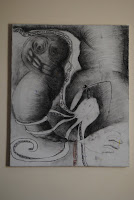Part 1 of this exhibition was Sonia Boyce collaborating with young parents. She showed students videos of young parents talking and the show is based around their reactions. I like how she has asked people the same age to comment on each other because this could be a touchy subject. She created a range of work from words on window panels, to words on canvases, with the words being quotes from the students. One white canvas showed tiny letters scattered around saying, "I'm not a boy.. shhhh" to another one saying, "I think she wanted it". These quotes are quite hard hitting because at the end of the day a baby is life, where ever it came from and whoever id the parents.

For part 2 of this exhibition Boyce worked in collaboration with the Blue Room at the Bluecoat. She was working along side people with learning difficulties and talking to them about their love and life. The layout of the room was 3 TV screens on the wall showing 3 people from the Blue Room. The TVs start and stop to take it in turns for each person to talk about their love. While this is happening and you start to get to know these people there is a big projection on the wall with all of the collaborators dancing and having a good time on Crosby beach. The whole set up makes you feel enlightened to see people, previously discussing first loves and so on just simply having a good time.

There is many contrasts in this whole room to the stillness of TVs stopping to then the sudden movement and talking. The naivety of the people with learning difficulties to them knowing a lot. The dancing brings up the rehearsed and natural and from having a conversation to it being staged.







